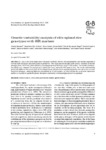Use este identificador para citar ou linkar para este item:
http://www.alice.cnptia.embrapa.br/alice/handle/doc/214369Registro completo de metadados
| Campo DC | Valor | Idioma |
|---|---|---|
| dc.contributor.author | BRONDANI, C. | pt_BR |
| dc.contributor.author | CALDEIRA, K. da S. | pt_BR |
| dc.contributor.author | BORBA, T. C. O. | pt_BR |
| dc.contributor.author | RANGEL. P. N. | pt_BR |
| dc.contributor.author | MORAIS, O. P. de | pt_BR |
| dc.contributor.author | CASTRO, E. da M. de | pt_BR |
| dc.contributor.author | RANGEL, P. H. N. | pt_BR |
| dc.contributor.author | MENDONÇA, J. A. | pt_BR |
| dc.contributor.author | BRONDANI, R. P. | pt_BR |
| dc.date.accessioned | 2011-06-06T16:57:29Z | - |
| dc.date.available | 2011-06-06T16:57:29Z | - |
| dc.date.created | 2006-09-05 | pt_BR |
| dc.date.issued | 2006 | pt_BR |
| dc.identifier.citation | Crop Breeding and Applied Biotechnology, v. 6, n. 1, p. 9-17, Mar. 2006. | pt_BR |
| dc.identifier.uri | http://www.alice.cnptia.embrapa.br/alice/handle/doc/214369 | pt_BR |
| dc.description | Rice is one of the staple foods consumed worldwide, and rice breeding programmes have become important to warrant high yield levels and grain quality in upland rice. Laboratory experiments were conducted to study the genetic variation of 30 elite genotypes from a VCU trial, of the upland rice breeding programme of Embrapa, Brazil, using 25 SSR markers. A total of 131 alleles were obtained, with an average of 5.2 alleles per locus and a mean PIC equal to 0.61. Results indicated that genetically different elite parents from the breeding programme and selection in segregating families have given rise to broad-based rice genotypes. Based on the analysis of different combinations of 10 SSR markers, it was observed that the use of more informative markers is essential to explain the genetic divergence consistently with the pedigree of each rice genotype.. | pt_BR |
| dc.language.iso | eng | eng |
| dc.rights | openAccess | eng |
| dc.subject | Marcador microssatélite | pt_BR |
| dc.subject | Distância genética | pt_BR |
| dc.subject | Microsatellite markers | pt_BR |
| dc.title | Genetic variability analysis of elite upland rice genotypes with SSR markers. | pt_BR |
| dc.type | Artigo de periódico | pt_BR |
| dc.date.updated | 2011-06-06T16:57:29Z | pt_BR |
| dc.subject.thesagro | Arroz | pt_BR |
| dc.subject.thesagro | Oryza Sativa | pt_BR |
| dc.subject.thesagro | Recurso Genético | pt_BR |
| dc.subject.nalthesaurus | genetic distance | pt_BR |
| dc.subject.nalthesaurus | genetic resources | pt_BR |
| dc.subject.nalthesaurus | rice | pt_BR |
| riaa.ainfo.id | 214369 | pt_BR |
| riaa.ainfo.lastupdate | 2011-05-05 | pt_BR |
| dc.contributor.institution | CLAUDIO BRONDANI, CNPAF | pt_BR |
| dc.contributor.institution | KAMYLLA DA SILVA CALDEIRA | eng |
| dc.contributor.institution | TEREZA CRISTINA DE OLIVEIRA BORBA, CNPAF | eng |
| dc.contributor.institution | PRISCILA NASCIMENTO RANGEL | eng |
| dc.contributor.institution | ORLANDO PEIXOTO DE MORAIS, CNPAF | eng |
| dc.contributor.institution | EMILIO DA MAIA DE CASTRO, CNPAF | eng |
| dc.contributor.institution | PAULO HIDEO NAKANO RANGEL, CNPAF | eng |
| dc.contributor.institution | JOAO ANTONIO MENDONCA, CNPAF | eng |
| dc.contributor.institution | ROSANA PEREIRA VIANELLO, CNPAF. | eng |
| Aparece nas coleções: | Artigo em periódico indexado (CNPAF)  | |
Arquivos associados a este item:
| Arquivo | Descrição | Tamanho | Formato | |
|---|---|---|---|---|
| CBABBrondani.pdf | 513,6 kB | Adobe PDF |  Visualizar/Abrir |









